Spectacular Winners Of The Insight Astronomy Photographer Of The Year 2017

“Stars and Nebulae”. Overall winner: The Rho Ophiuchi Clouds, by Artem Mironov (Russia) The Rho Ophiuchi Cloud Complex, or the Ophiuchus Molecular Cloud is a dark emission and reflection nebula about 14 light years across situated approximately 460 light years away from earth, in the constellation of Ophiuchus (the “Serpent-Bearer”). It is one of the closest star-forming regions to the Solar System. Hakos Farm, Windhoek, Namibia, 6 August 2016. Sky-Watcher 200 mm f/4 reflector telescope, Sky-Watcher HEQ5 Pro mount, Canon 5D Mark II camera, ISO 1600, 15-hour total exposure. (Photo by Artem Mironov/Insight Astronomy Photographer of the Year 2017)
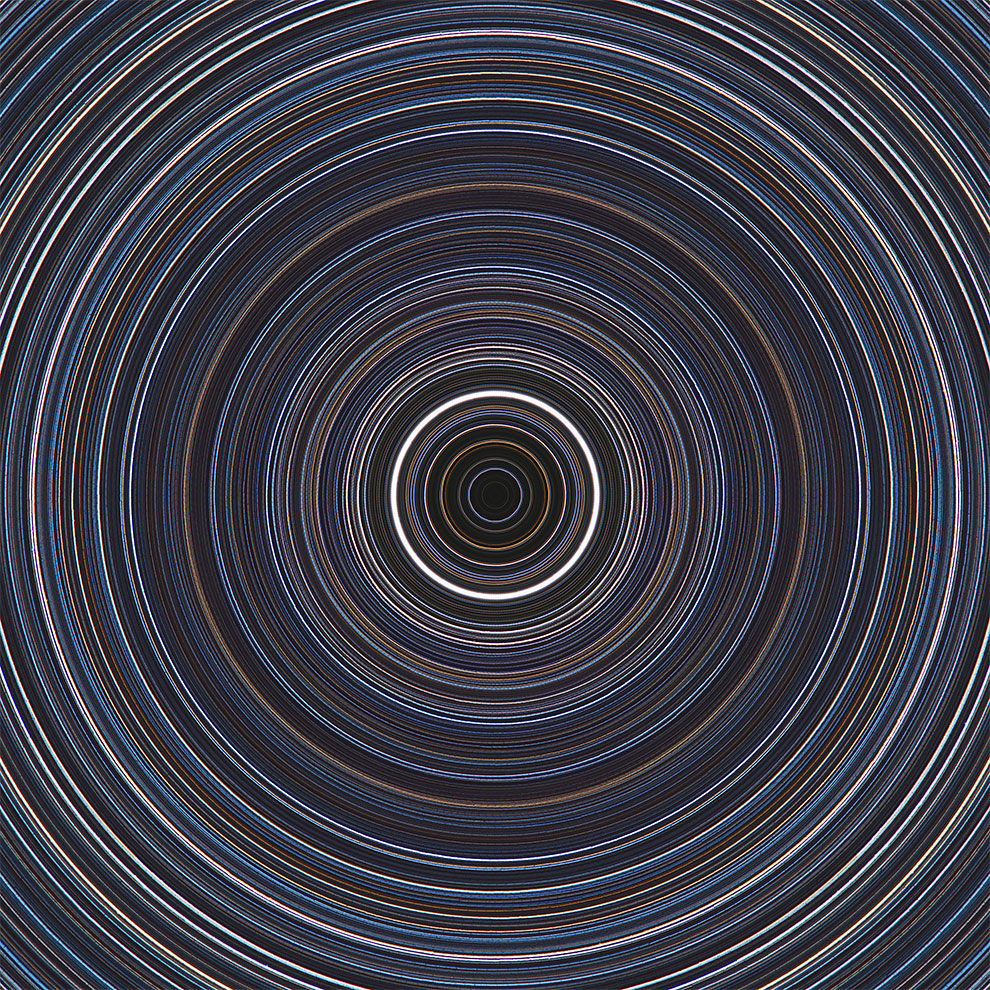
“Stars and Nebulae”. Runner up: One Stellar Day by Andras Papp (Hungary) A 24 hour day actually only takes 23 hours, 56 minutes and 4 seconds for our planet spinning on its axis to complete one rotation – known as the “sidereal day” or “stellar day”. This image captures the motion of the stars over the course of one “stellar day” illustrated by beautiful concentric star trails. Ágasvár, Veszprémvarsány, Hungary, 2 November 2016 Canon EOS 700D camera, 18–135 mm at 135 mm f/7.1, Sky-Watcher HEQ5 mount with home-made camera holder, ISO 800, 287 x 300-second exposures. (Photo by Andras Papp/Insight Astronomy Photographer of the Year 2017)
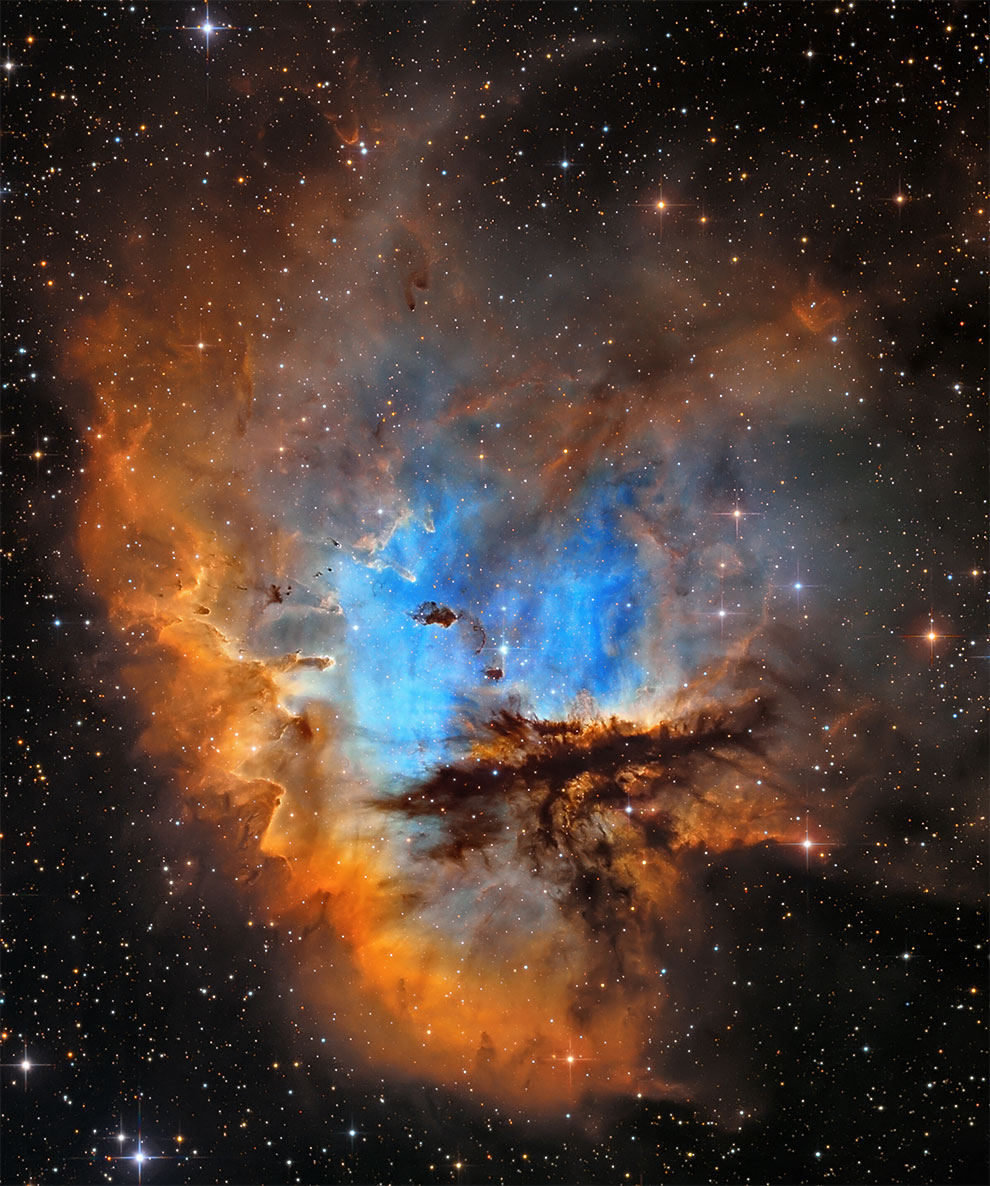
“Stars and Nebulae”. Highly commended: NGC 281 Pacman by Andriy Borovkov (Ukraine) The NGC 281 nebula is known as the “Pacman Nebula” due to its resemblance to the video game character. In the ordinary colours of the visible light spectrum it can look rather dreary, so this image used the Hubble Palette (HST), showcasing the nebula with a vibrant blue surrounded by rusty oranges. Elmshorn, Germany, August/September 2016. UNC 30512 305 mm f/4 reflector telescope, Sky-Watcher EQ8 mount, Moravian Instruments G2-8300 Mono CCD camera, 25-hour total exposure. (Photo by Andriy Borovkov/Insight Astronomy Photographer of the Year 2017)
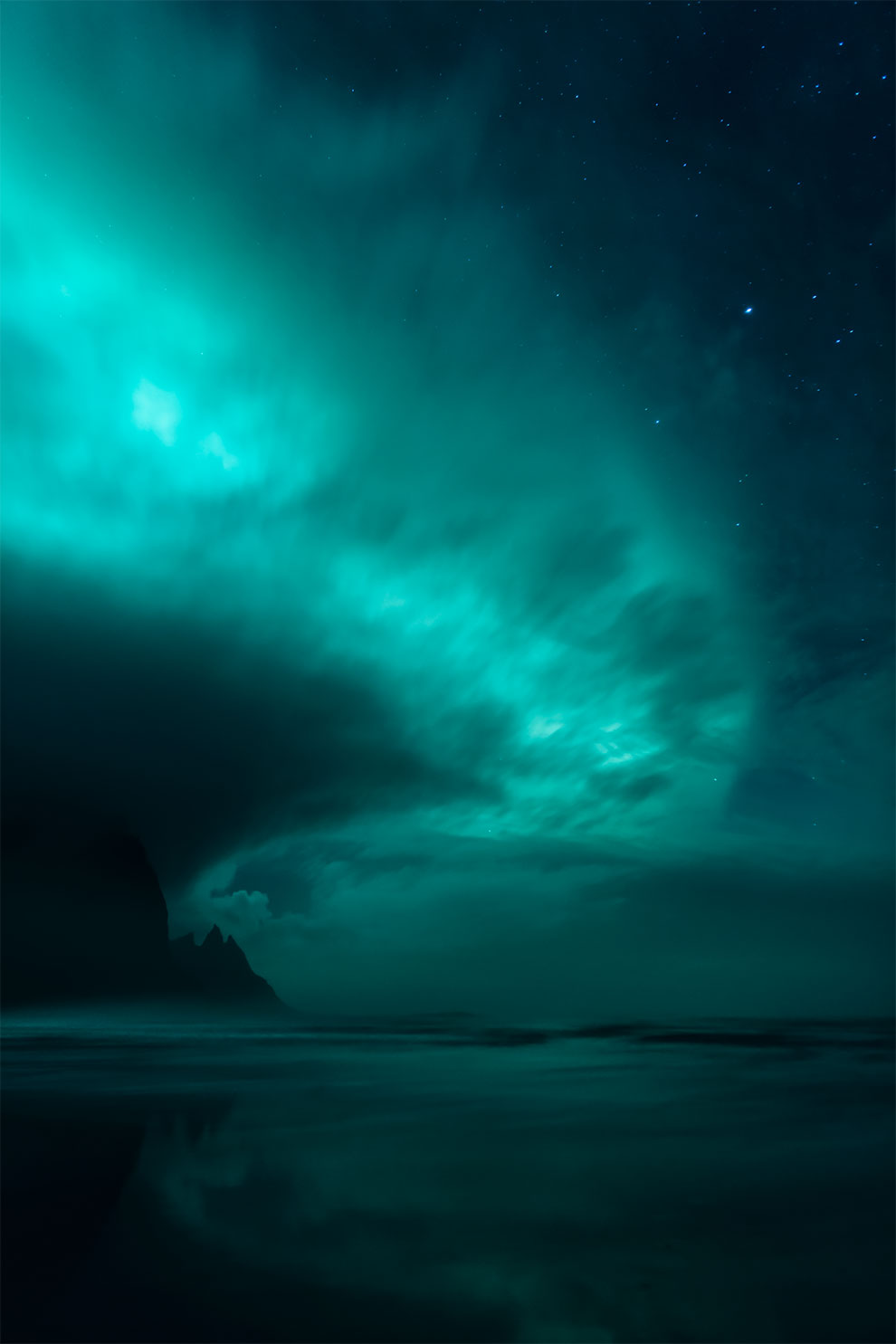
“Aurorae”. Winner: Ghost World by Mikkel Beiter (Denmark) During October 2016 the photographer stood and observed the waves from the sea slowly rolling up on the long beach making the sand wet, resulting in great conditions for catching some reflections. Suddenly, clouds emerged from the nearby mountains and floated across the sea allowing him to capture this other-worldly scene of a powerful, teal aurora sweeping across the night sky. Stokksnes, Iceland. Stokksnes, Iceland, 5 October 2016 Canon EOS 5D Mark III camera, 24 mm f/2.0 lens, ISO 1600, 6-second exposure. (Photo by Mikkel Beiter/Insight Astronomy Photographer of the Year 2017)
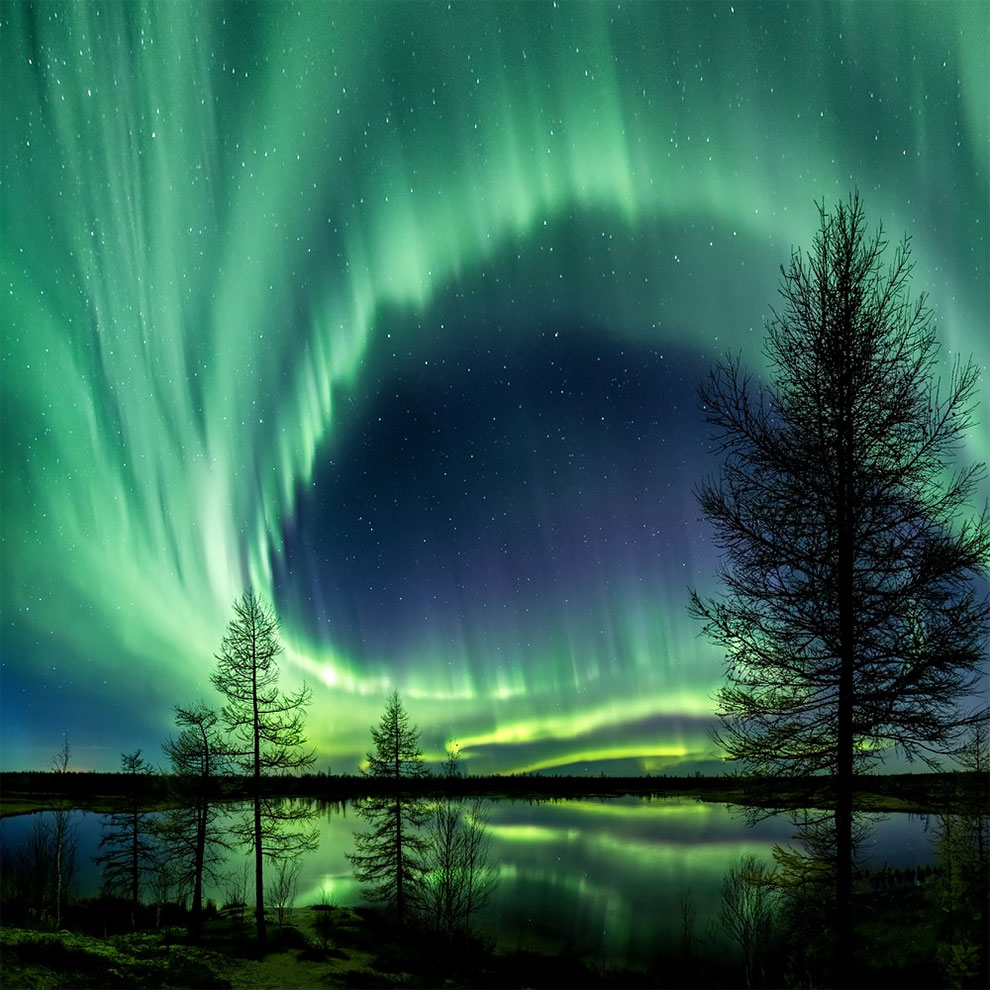
“Aurorae”. Runner up: In Autumn Dance by Kamil Nureev (Russia) A glowing green auroral ray arcs through the night sky over the Siberian forest-tundra. Eight vertical scenes shot – over the course of shooting, every second was precious as the polar light was very dynamic and the photographer had to move as quickly as possible to authentically capture the scene. The polar shine silhouette reminds the photographer of the mathematical “golden ratio”. Noviy Urengoy, Russia, 28 September 2016 Canon 5D Mark III camera, 24 mm f/2.0 lens, ISO 2000, 4-second exposure. (Photo by Kamil Nureev/Insight Astronomy Photographer of the Year 2017)

“Aurorae”. Highly commended: Aurora Shot from Plane by Ye Ziyi (China) The vivid green aurora swirls over the deep, blue sky and the orange glow of twilight as seen from the window of a plane travelling from Amsterdam to Beijing. The photographer had been expecting an auroral outburst to occur during the flight, so paid for the seat that was best for observing. As well as the strong auroral activity, the photographer was also blessed with a white night making twilight visible on the horizon. Novosbirsk, Russia, 24 August 2016 Canon EOS 6D camera, 20 mm f/1.8 lens, ISO 2000, 3-second exposure. (Photo by Ye Ziyi/Insight Astronomy Photographer of the Year 2017)
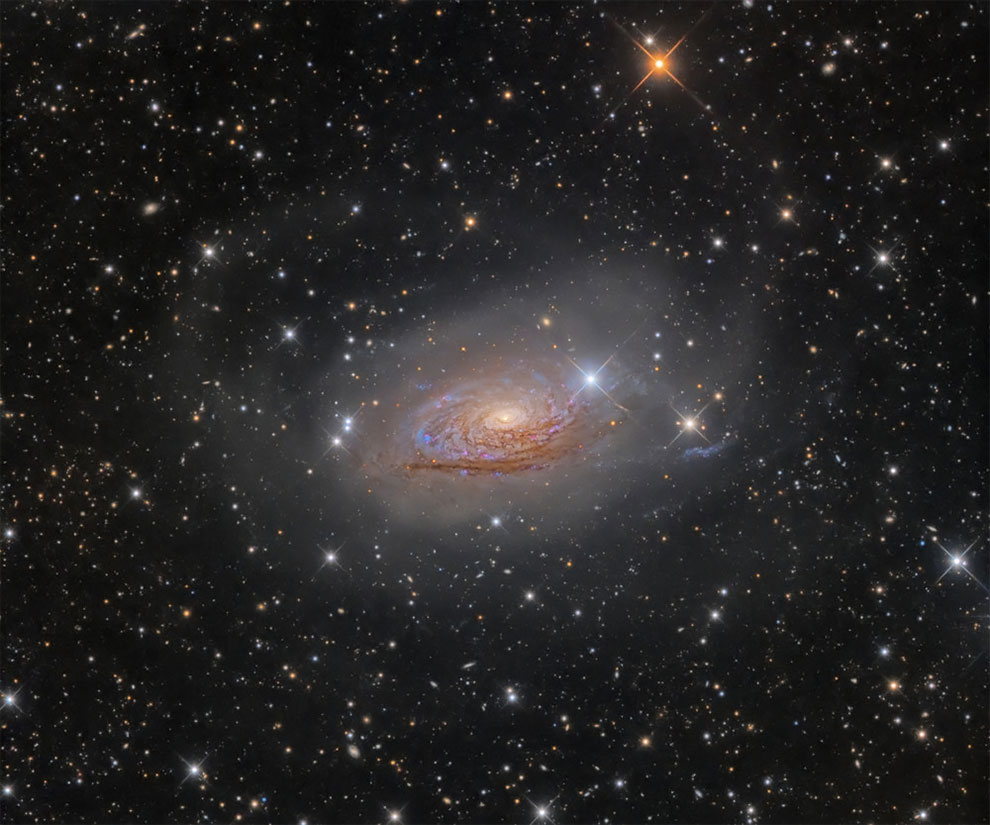
“Galaxies”. Winner: M63 – Star Streams and the Sunflower Galaxy by Oleg Bryzgalov (Ukraine) A bright, spiral galaxy, Messier 63 looks like a star necklace in which the stars have crashed outwards from the galaxy’s centre, producing this fantastic long train. The ghostly star arcs of the Sunflower galaxy had long been an elusive target for the photographer, finally shot in one of the darkest places in Europe. Rozhen Observatory, Smolyan Province, Bulgaria, 6 April 2016 10-inch f/3.8 homemade reflector telescope at f/4.4, Whiteswan 180 mount, QSI 583wsg camera, 22-hour total exposure. (Photo by Oleg Bryzgalov/Insight Astronomy Photographer of the Year 2017)

“Galaxies”. Runner up: NGC 7331 – The Deer Lick Group by Bernard Miller (USA) NGC 7331 is an unbarred spiral galaxy found some 40 million light years away from Earth, in the constellation Pegasus. Of the group of galaxies known as the Deer Lick Group, NGC 7331 is the largest, and can be seen dominating the image whilst the smaller galaxies NGC 7335, NGC 7336, NGC 7337, NGC 7338 and NGC 7340 drift above it. Animas, New Mexico, USA, 30 October 2016 PlaneWave CDK-17 17-inch reflector telescope at f/6.8, Paramount ME mount, Apogee CG16M camera, 18-hour total exposure. (Photo by Bernard Miller/Insight Astronomy Photographer of the Year 2017)

“Galaxies”. Highly Commended: NGC 4565 – Needle Galaxy by Andriy Borovkov (Ukraine) NGC 4565 in the constellation of Coma Berenices, approximately 40 million light years away, is known as the Needle Galaxy and is more luminous than our neighbouring galaxy, Andromeda. As we look at this galaxy from the side on Earth, the spiral arms are in a ray. Elmshorn, Pinneberg, Schleswig-Holstein, Germany, 14 March 2016 UNC 30512 300 mm f/4 reflector telescope, Sky-Watcher EQ8 mount, Moravian Instruments G2-8300 mono camera, 9.-hour total exposure. (Photo by Andriy Borovkov/Insight Astronomy Photographer of the Year 2017)

“Our moon”. Winner: Blue Tycho by László Francsics (Hungary) This hyper-saturated picture shows our lunar surface in a new light. The Tycho Crater, has a bluish shade that is characteristic of the youngest craters on the moon. Budapest, Hungary, 12 December 2016 250 mm f/4 reflector telescope at f/10, Sky-Watcher EQ6 mount, ZWO ASI290MM and Sony SLT A99V cameras, composite of 5000 monochrome frames and 50 colour frames. (Photo by László Francsics/Insight Astronomy Photographer of the Year 2017)

“Our moon”. Runner up: Evening in the Ptolemaeus Chain and Rupes Recta Region by Jordi Delpeix Borrell (Spain) A close up of the craggy face of the moon, shows the south central lunar face is dominated by the magnificent chain of walled plains: Ptolemaeus, Alphonsus and Arzachel. L’ Ametlla del Vallès, Barcelona, Spain, 25 August 2016 Celestron C14 355.6 mm f/11 Scmidt-Cassegrain telescope at f/19, Sky-Watcher NEQ6 Pro mount, ZWO ASI 174MM camera, 500 of 6600 frames stacked. (Photo by Jordi Delpeix Borrell/Insight Astronomy Photographer of the Year 2017)

“Our moon”. Highly commended: Mauna Kea Moonset by Sean Goebel (USA) A giant moon looms behind the telescopes atop the snow-capped dormant volcano, Mauna Kea. Despite being in Hawaii, Mauna Kea is tall enough (4,200m) to accumulate snow during the winter. The telescopes are, from left to right, the UK Infrared Telescope, the University of Hawaii 2.2m telescope, Gemini North, and Canada France Hawaii Telescope. Hilo, Hawaii, USA, 13 January 2017 Canon EOS 7D Mark II, 1000 mm f/11 lens, ISO 320, 1/500-second exposure. (Photo by Sean Goebel/Insight Astronomy Photographer of the Year 2017)

“Our sun”. Winner: Mercury Rising by Alexandra Hart (UK) On 9 May 2016, the Transit of Mercury occurred, with the smallest planet in the solar system passing directly between the Earth and the sun over the course 7.5 hours – the longest transit of the century. Mercury can be seen towards the centre of our star in the image as a tiny black dot. Preston, Lancashire, UK, 9 May 2016 TEC140 140 mm f/7 refractor telescope at f/9.8, Solarscope DSF100 H-alpha filter, Sky-Watcher EQ6 Pro mount, PGR Grasshopper 3 camera, stacked from multiple exposures. (Photo by Alexandra Hart/Insight Astronomy Photographer of the Year 2017)
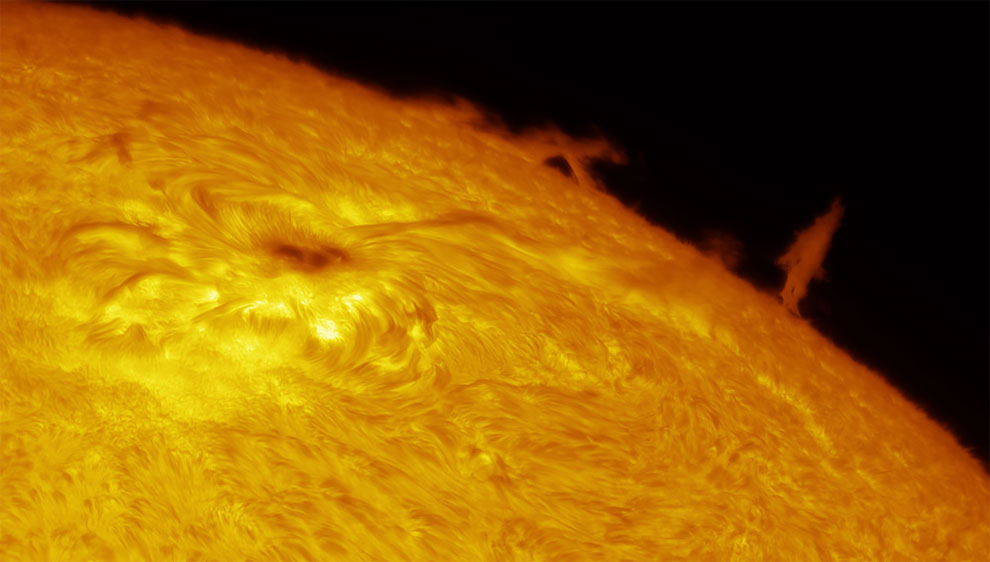
“Our sun”. Runner up: Solar Limb Prominence and Sunspot by Eric Toops (USA) A striking image of a searing solar limb prominence and sunspot on the surface of our star, taken during the spring of 2016. Using Lunt H-alpha filters in a custom-made telescope the photographer was able to bring out the details of the solar activity using high magnification. Several photos were stacked to stabilize the image and the “seeing conditions” (the blurriness of the Earth’s atmosphere). Hoschton, Georgia, USA, 19 April 2016 Home-made telescope, Point Grey GS3-U3-60S6M camera. (Photo by Eric Toops/Insight Astronomy Photographer of the Year 2017)
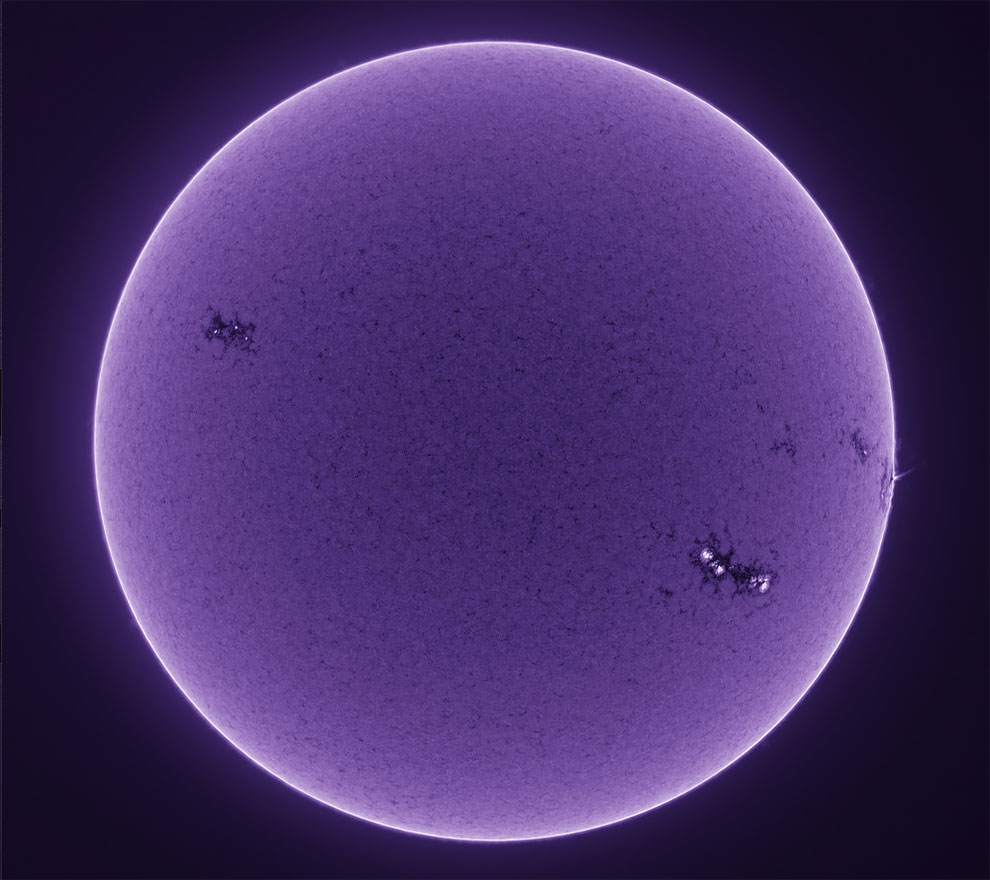
“Our sun”. Highly commended: Ghostly Sun by Michael Wilkinson (UK) The sun photographed in Calcium-K light, depicting the star’s inner chromosphere. In the colour-rendering scheme used, the surface is shown as negative, with the sunspots as bright spots, but the area outside the limb is shown with increased contrast, highlighting a surge on the western limb, and several small prominences. Groningen, Netherlands, 4 April 2017 APM 80 mm f/6 refractor telescope, Vixen Great Polaris mount, ZWO ASI178MM camera, stack of 400 frames. (Photo by Michael Wilkinson/Insight Astronomy Photographer of the Year 2017)

“Planets, Comets and Asteroids”. Winner: Venus Phase Evolution by Roger Hutchinson (UK) The changing face the planet Venus as it grew from 86.6% illuminated and 11.9 inches in diameter on the 25th September 2016, to 1% illuminated and 59.3 inches in diameter six months later. The images were taken with the same setup, so the changing size of Venus, as it approached the point between us and the sun, is apparent. London, UK, 25 March 2017 Celestron C11 EdgeHD 355.6 mm f/10 reflector telescope, Celestron CGE Pro mount, ZWO ASI174MM camera, composite of panels stacked from multiple exposures. (Photo by Roger Hutchinson/Insight Astronomy Photographer of the Year 2017)
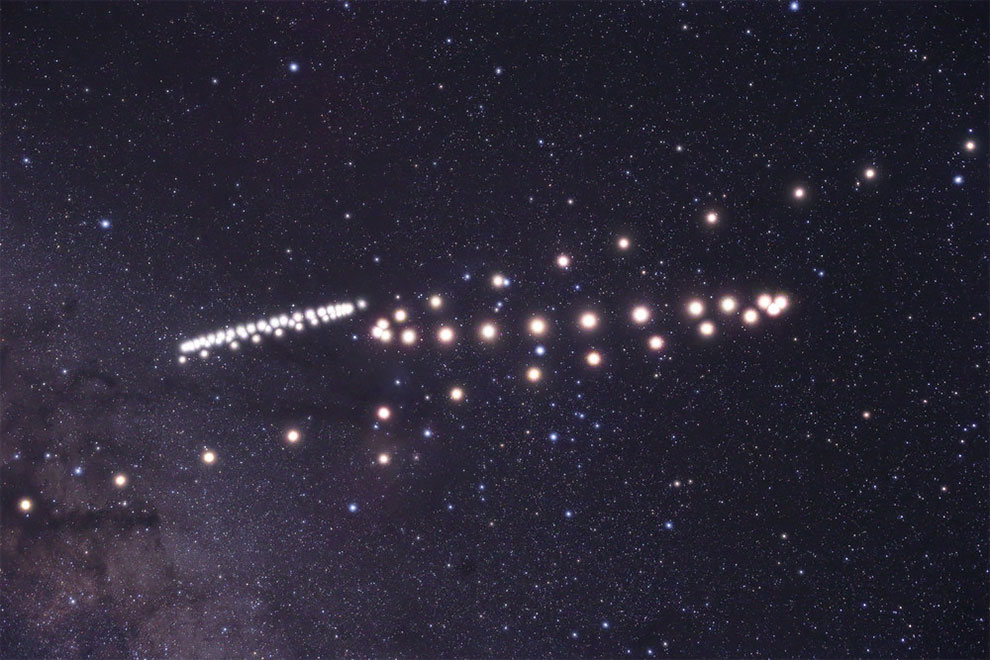
“Planets, Comets and Asteroids”. Runner up: Retrograde Mars and Saturn by Tunç Tezel (Turkey) The paths of the planets Mars and Saturn shown swooping through the night sky, over a period of 11 months in 2016. Last year was a special year for monitoring the two planets because they spent the year close to each other, north of Antares in Scorpius. The planets were photographed on 46 different dates over 11 months, roughly once per week. Pulau Plun, Halmahera, Indonesia, 9 March 2016 Canon EOS 6D camera, 50 mm f/3.5 lens, ISO 3200, composite of multiple exposures. (Photo by Tunç Tezel/Insight Astronomy Photographer of the Year 2017)
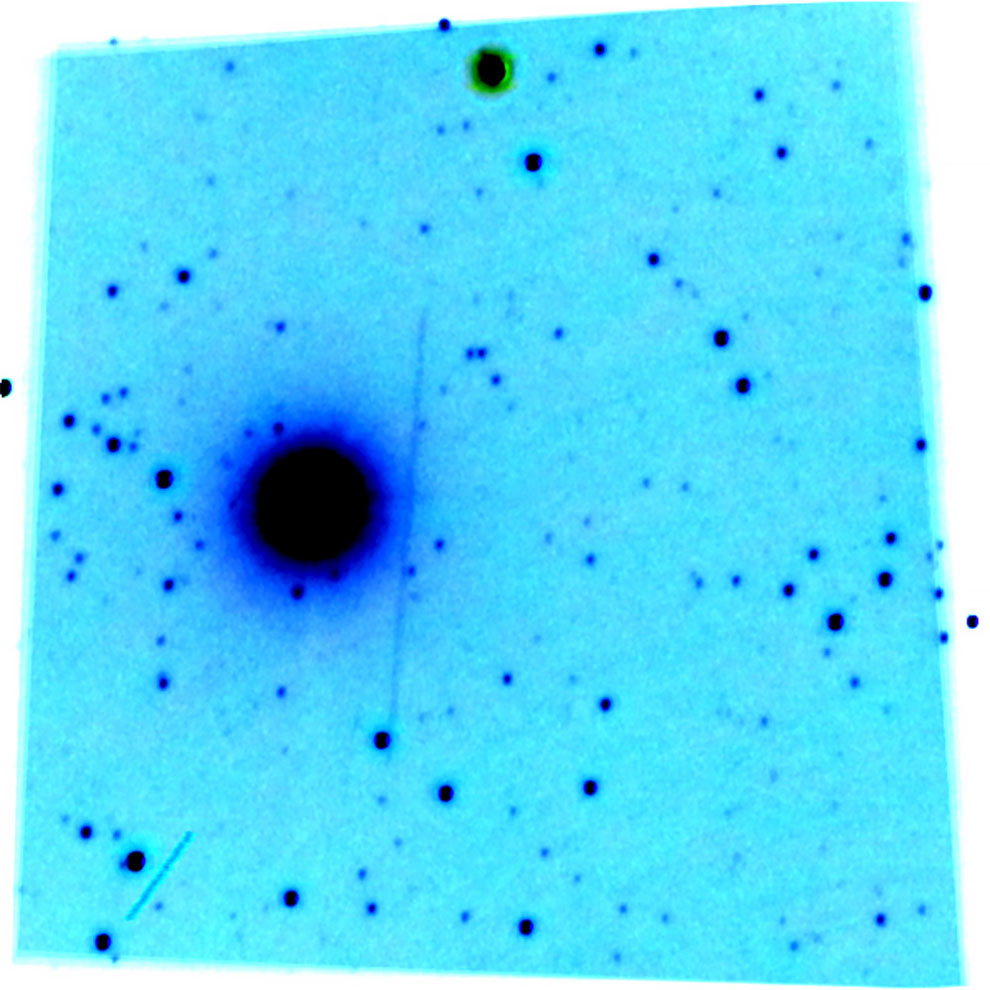
“Planets, Comets and Asteroids”. Highly commended: Near Earth Object 164121 (2003 YT1) by Derek Robson (UK) On 31 October 2016, Near Earth Asteroid 164121 (2003 YT1) made a close encounter with Earth at 3 million miles. This Apollo asteroid with an orbital period of 427 days was discovered by the Catalina Sky Survey on 18 December 2003. The photographer’s first attempt at imaging the asteroid was done with a camera on a fixed tripod, controlled by Astrophotography Tool software. Loughborough, Leicestershire, UK, 2 November 2016 Canon 1100D, 300 mm f/5.6 lens, ISO 1600, 56 x 25-second exposures. (Photo by Derek Robson/Insight Astronomy Photographer of the Year 2017)
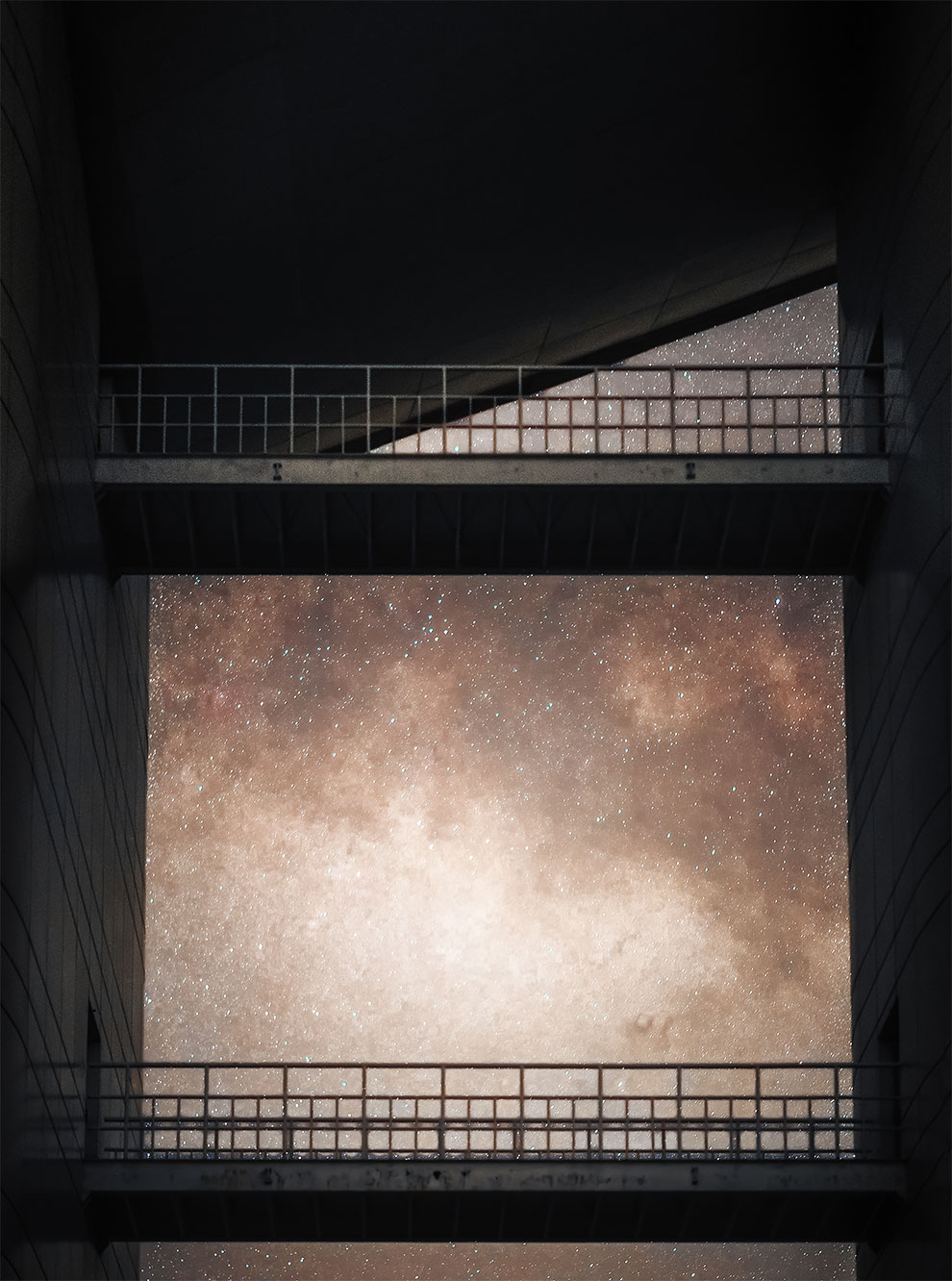
“Skyscapes”. Winner: Passage to the Milky Way by Haitong Yu (China) The serene sight of the dusky, Milky Way viewed through the minimalist outdoor passageway of LAMOST (the Large Sky Area Multi-Object Fibre Spectroscopic Telescope) at the National Astronomical Observatory of China. Shot with an 85 mm lens, the image is a composite of a three-panel panorama, each one with a single exposure. Xinglong, Hebei Province, China, 9 April 2016 Sony ILCE-7s camera, 85 mm f/1.4 lens, ISO 10000, panorama of three 8-second exposures . (Photo by Haitong Yu/Insight Astronomy Photographer of the Year 2017)
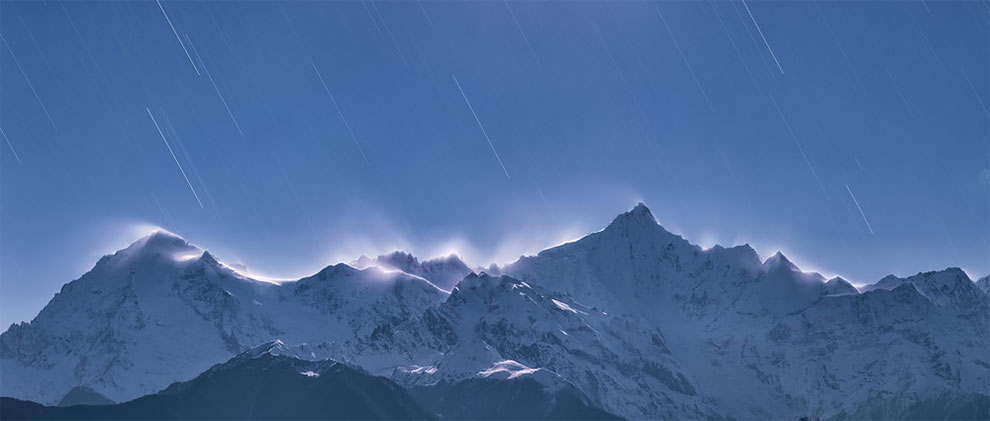
“Skyscapes”. Runner up: Star Track in Kawakarpo by Zhong Wu (China) The stars beam down on to the Meili Snow Mountains, also known as the Prince Snow Mountains – the highest peaks in the Yunnan Province, China. It is world-renowned for its beauty and is one of the most sacred mountains in Tibetan Buddhism. The moonlight striking the top of the mountains appears to give them an ethereal quality. DeQin, Yunnan Province, China, 16 January 2017 Nikon D810 camera, 35 mm f/5.6 lens, ISO 200, 900-second exposure. (Photo by Zhong Wu/Insight Astronomy Photographer of the Year 2017)
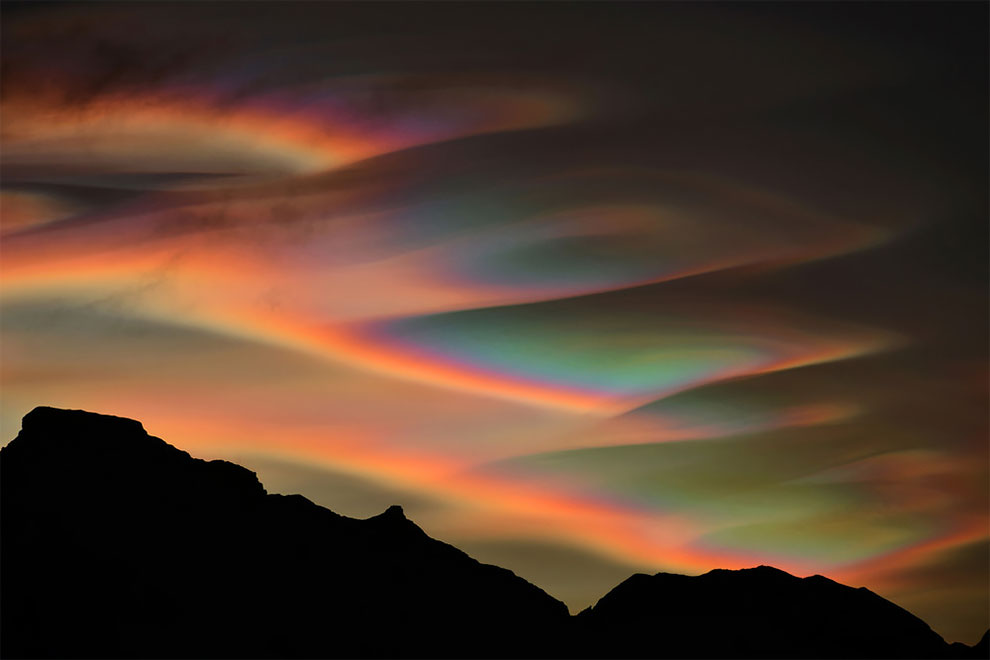
“Skyscapes”. Highly commended: Nacreous Clouds by Bartlomiej Jurecki (Poland) A spectrum of colour rolls across the sky over Lofoten, Norway in the form of nacreous clouds, also known as mother-of-pearl clouds due to their almost shimmering appearance. Formed over the Polar Regions in the stratosphere, when the Sun is just below the horizon at sunset it will illuminate the clouds from below. Lofoten, Norway, 31 December 2016 Nikon D800 camera, 300 mm f/7.1 lens, ISO 10, 1/800-second exposure. (Photo by Bartlomiej Jurecki/Insight Astronomy Photographer of the Year 2017)

“Young Astronomy Photographer of the Year”. Highly commended: Milky Way above Alpe di Siusi/Dolomites by Fabian Dalpiaz (Italy – aged 15) The Milky Way stretches across the night sky above the Dolomites in South Tyrol at 5.00 a.m. on a really cold winter morning. Reaching the spot at 4.00 a.m. the photographer waited for the Milky Way to reach its highest position before it got brighter to capture this beautiful scene. Seiser Alm, South Tyrol, Italy, 25 February 2017 Canon EOS 5D Mark III camera, 50 mm f/1.8 lens, ISO 6400, 10-second exposure. (Photo by Fabian Dalpiaz/Insight Astronomy Photographer of the Year 2017)

“Young Astronomy Photographer of the Year”. Highly commended: Rosa Mountain by Andrea Imazio (Italy – aged 8) Taken during a crystal clear winter night as a single long exposure, this image shows the stars glistening above the Rosa Massif Mountain in the Alps. Gressoney, Aosta Valley, Italy, 3 January 2017 Nikon D5500 camera, 18 mm f/3.5 lens, ISO 1600, 20-second exposure. (Photo by Andrea Imazio/Insight Astronomy Photographer of the Year 2017)
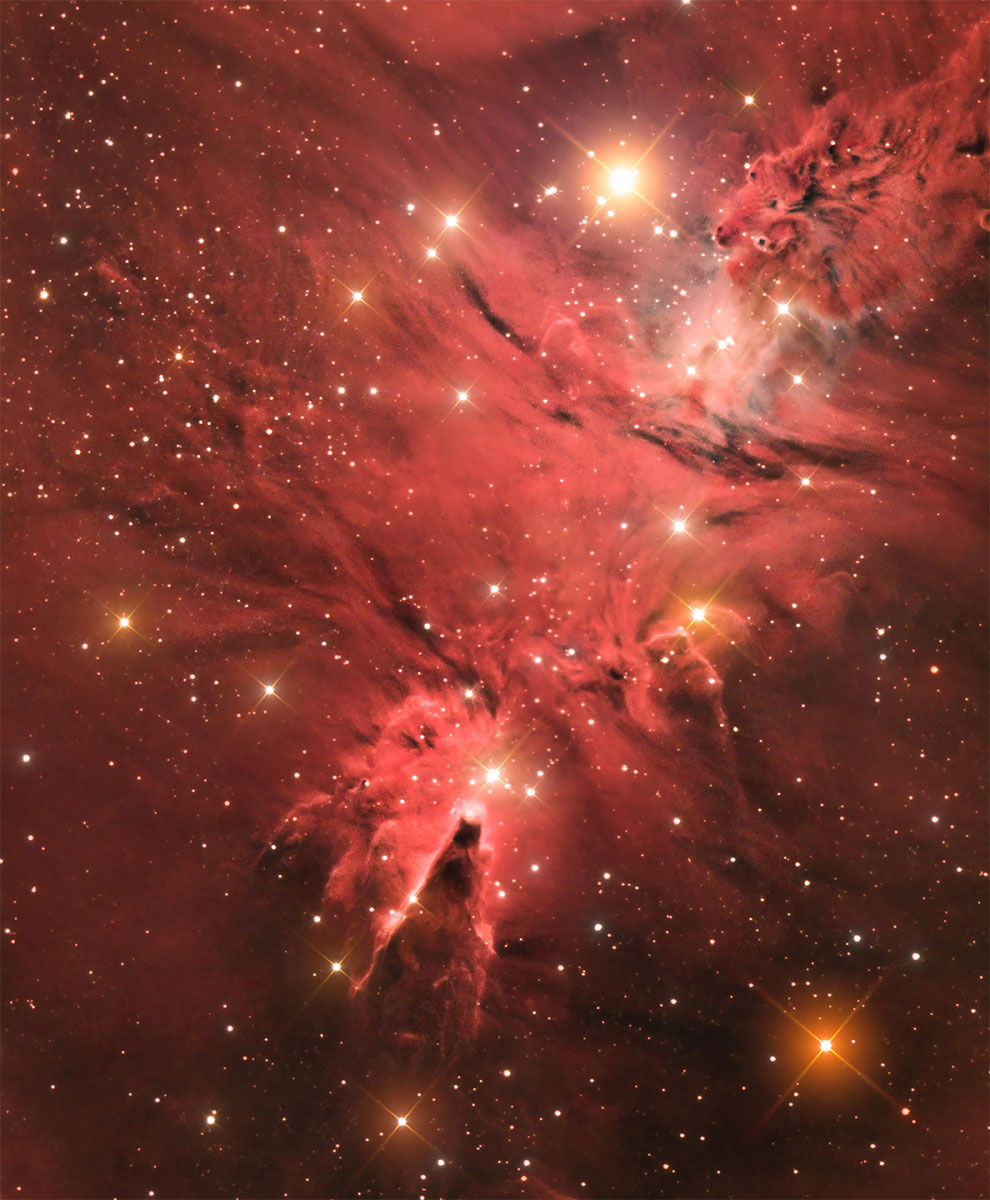
“Sir Patrick Moore Prize for Best Newcomer”. Winner: The Cone Nebula (NGC 2264) by Jason Green (Gibraltar) A vivid deep-red image of the Cone Nebula, lying about 2,700 light years away in the constellation of Monoceros. The image consists of 20 x 10-minute exposures per filter and is an integration of LRGB (luminance, red, green and blue) and H-Alpha (hydrogen-alpha) filters. Frenegal de la Sierra, Badajoz, Spain, 10 January 2017 William Optics 132 mm f/5.6 apochromatic refractor telescope, Celestron CGE Pro mount, QSI 660WSG8 Mono CCD camera, 16 2/3-hour total exposure. (Photo by Jason Green/Insight Astronomy Photographer of the Year 2017)
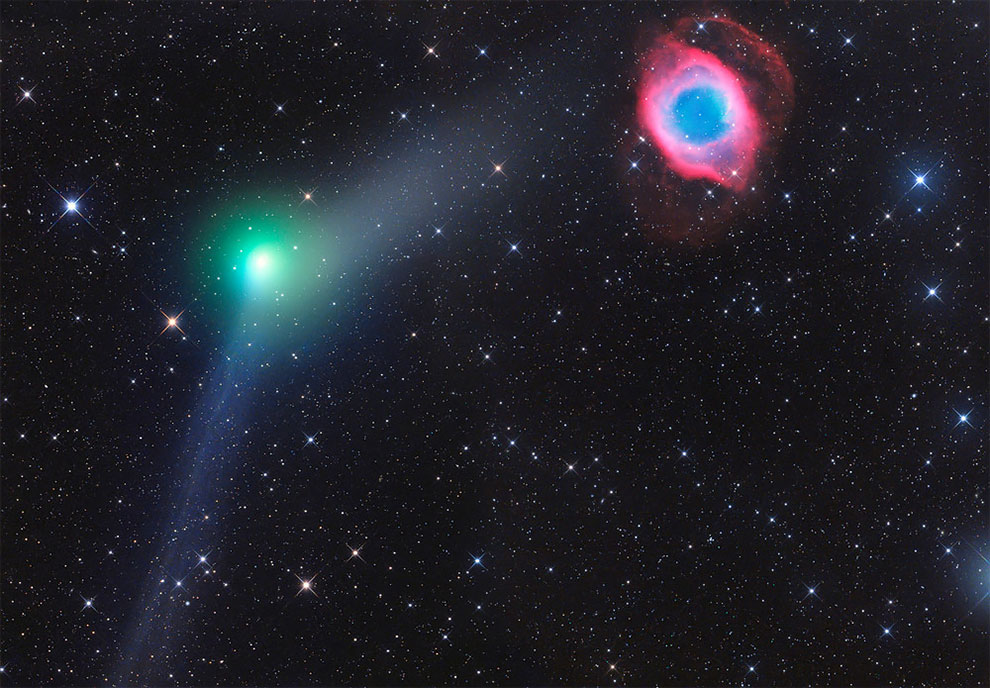
“Robotic Scope”. Winner: Encounter of Comet and Planetary Nebula by Gerald Rhemann (Austria) A vibrant image showing the glowing green, comet C/2013 X1 PanSTARRS whizzing past the luminous pink and blue Helix Planetary Nebula, on 5 June 2016. This photograph was taken at an observatory on Tivoli Farm in Namibia, where the photographer installed a mount and telescope with a friend of his. Tivoli Farm, Khomas, Namibia, 5 June 2016 ASA Astrograph 12-inch N 300 mm f/3.6 reflector telescope, ASA DDM 85 mount, FLI Microline ML 16200 camera, 94-minute total exposure. (Photo by Gerald Rhemann/Insight Astronomy Photographer of the Year 2017)
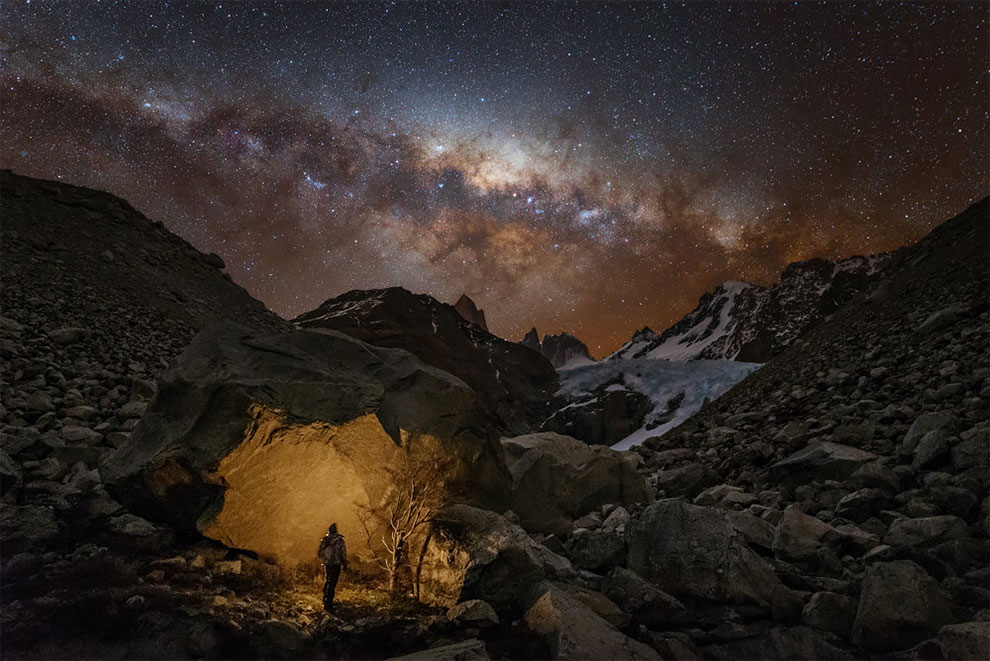
“People and Space”. Winner: Wanderer in Patagonia by Yuri Zvezdny (Russia) A lone stargazer stares up at the stars of our galaxy, the Milky Way, as they stretch across the night sky over the glacier “White Stones” (Piedras Blancas) in the Los Glaciares National Park, Argentina. El Chaltén, Santa Cruz Province, Argentina, 27 September 2016 iOptron Sky-Tracker mount, Sony A7S camera, 18 mm f/2.8 lens, ISO 5000, 30-second exposure Wanderer in Patagonia. (Photo by Yuri Zvezdny/Insight Astronomy Photographer of the Year 2017)
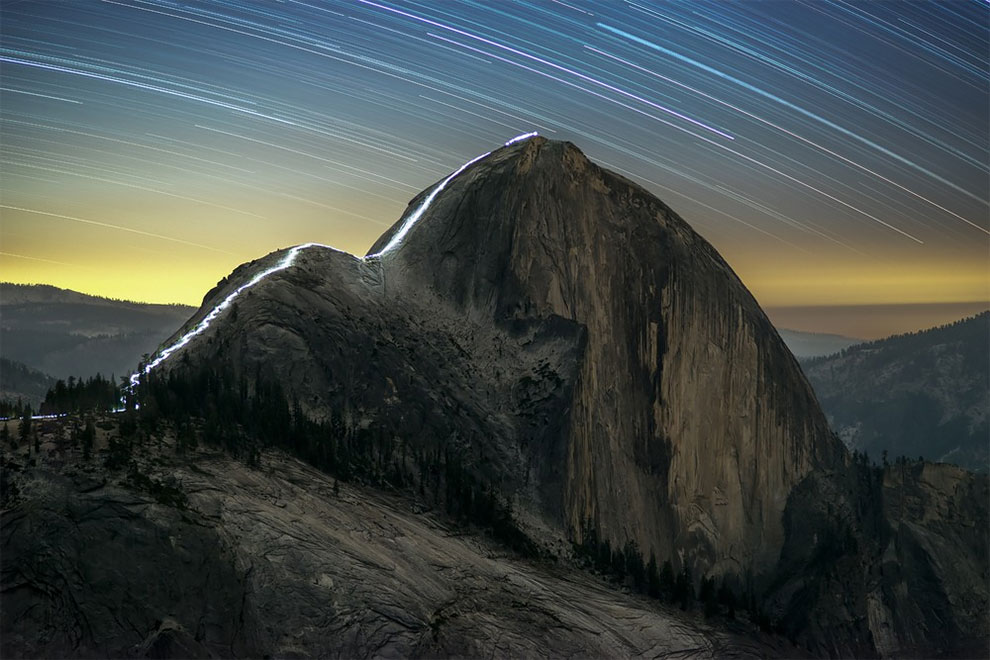
“People and Space”. Runner up: The Cable Route of Half Dome at Night by Kurt Lawson (USA) The photographer along with fellow astrophotographer Sean Goebel embarked on a mission to shoot a night hike up the Cable Route of Yosemite’s incredible Half Dome. Nearly clear skies allowed for the capture of the movement of the stars above this incredible landscape and shooting it at night allowed them to capture the path up Yosemite’s famous granite icon. Yosemite National Park, California, USA, 29 August 2016 Sony α7R camera, 100 mm f/2.8 lens, ISO 500, 64-minute exposure. (Photo by Kurt Lawson/Insight Astronomy Photographer of the Year 2017)
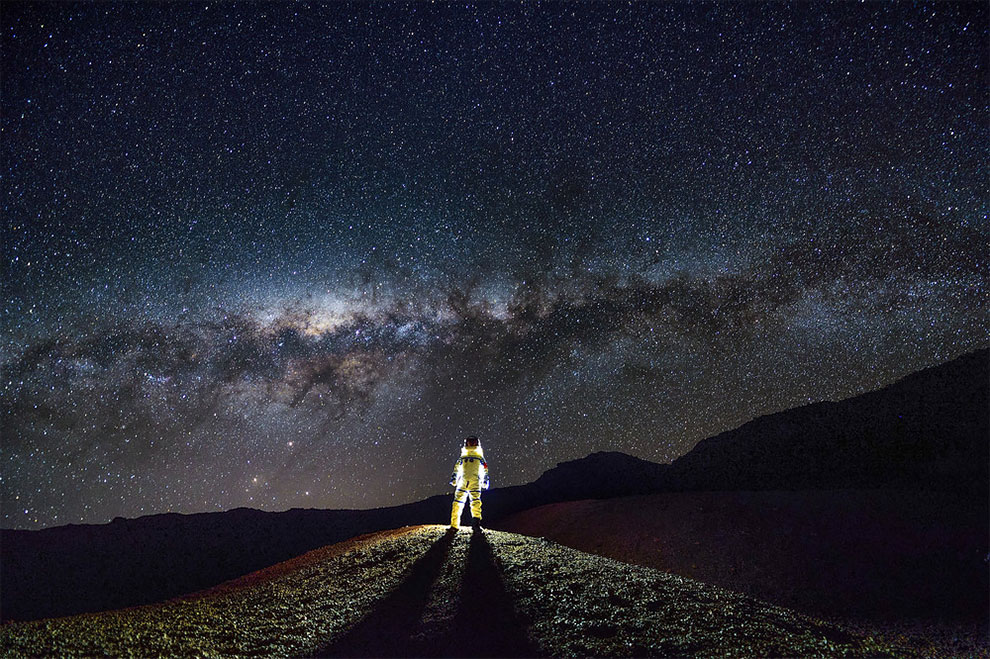
“People and Space”. Highly commended: Interstellar Travel by Fu Dingyan (China) In an attempt to recreate feeling of travelling in space, the photographer escaped the lights of the city and ventured to Réunion Island, located off the coast of Madagascar. Dressed in a spacesuit, standing under the southern Milky Way and the Large and Small Magellanic Clouds, the photographer resembles an interstellar traveller Réunion Island, France, 3 September 2016 Nikon D4S camera, 14-24 mm lens at 14 mm f/2.8, ISO 500, 30-second exposure. (Photo by Fu Dingyan/Insight Astronomy Photographer of the Year 2017)